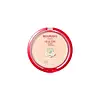Bourjois Paris Healthy Mix Powder Versus La Roche-Posay Toleriane Teint Mineral Compact Powder SPF 25
What's inside
What's inside
 Key Ingredients
Key Ingredients

 Benefits
Benefits

No benefits
 Concerns
Concerns

 Ingredients Side-by-side
Ingredients Side-by-side

Mica
Cosmetic ColorantKaolin
AbrasiveZinc Stearate
Cosmetic ColorantAvena Sativa Kernel Flour
AbrasiveIsopropyl Palmitate
EmollientOctyldodecyl Stearoyl Stearate
EmollientDimethicone
EmollientLauroyl Lysine
Skin ConditioningParfum
MaskingSorbitan Sesquioleate
EmulsifyingCaprylyl Glycol
Emollient1,2-Hexanediol
Skin ConditioningSodium Benzoate
MaskingTocopheryl Acetate
AntioxidantPunica Granatum Fruit Juice
MaskingEuterpe Oleracea Juice
Skin ConditioningAscorbyl Palmitate
AntioxidantPanthenol
Skin ConditioningGlycerin
HumectantWater
Skin ConditioningLycium Barbarum Fruit Extract
AstringentPantolactone
HumectantPotassium Sorbate
PreservativeCI 77891
Cosmetic ColorantIron Oxides
Mica, Kaolin, Zinc Stearate, Avena Sativa Kernel Flour, Isopropyl Palmitate, Octyldodecyl Stearoyl Stearate, Dimethicone, Lauroyl Lysine, Parfum, Sorbitan Sesquioleate, Caprylyl Glycol, 1,2-Hexanediol, Sodium Benzoate, Tocopheryl Acetate, Punica Granatum Fruit Juice, Euterpe Oleracea Juice, Ascorbyl Palmitate, Panthenol, Glycerin, Water, Lycium Barbarum Fruit Extract, Pantolactone, Potassium Sorbate, CI 77891, Iron Oxides
Talc
AbrasivePerlite
AbsorbentNylon-12
Titanium Dioxide
Cosmetic ColorantDimethicone
EmollientMagnesium Stearate
Cosmetic ColorantTriisocetyl Citrate
EmollientStearic Acid
CleansingTrimethylsiloxysilicate
EmollientCaprylyl Glycol
EmollientParaffinum Liquidum
EmollientCetyl Dimethicone
EmollientLauroyl Lysine
Skin ConditioningAluminum Hydroxide
EmollientCI 77891
Cosmetic ColorantCI 77163
Cosmetic ColorantCI 77491
Cosmetic ColorantCI 77492
Cosmetic ColorantCI 77499
Cosmetic ColorantMica
Cosmetic ColorantIngredients Explained
These ingredients are found in both products.
Ingredients higher up in an ingredient list are typically present in a larger amount.
Caprylyl Glycol is a humectant and emollient, meaning it attracts and preserves moisture.
It is a common ingredient in many products, especially those designed to hydrate skin. The primary benefits are retaining moisture, skin softening, and promoting a healthy skin barrier.
Though Caprylyl Glycol is an alcohol derived from fatty acids, it is not the kind that can dry out skin.
This ingredient is also used as a preservative to extend the life of products. It has slight antimicrobial properties.
Learn more about Caprylyl GlycolCi 77891 is a white pigment from Titanium dioxide. It is naturally found in minerals such as rutile and ilmenite.
It's main function is to add a white color to cosmetics. It can also be mixed with other colors to create different shades.
Ci 77891 is commonly found in sunscreens due to its ability to block UV rays.
Learn more about CI 77891Dimethicone is a type of synthetic silicone created from natural materials such as quartz.
What it does:
Dimethicone comes in different viscosities:
Depending on the viscosity, dimethicone has different properties.
Ingredients lists don't always show which type is used, so we recommend reaching out to the brand if you have questions about the viscosity.
This ingredient is unlikely to cause irritation because it does not get absorbed into skin. However, people with silicone allergies should be careful about using this ingredient.
Note: Dimethicone may contribute to pilling. This is because it is not oil or water soluble, so pilling may occur when layered with products. When mixed with heavy oils in a formula, the outcome is also quite greasy.
Learn more about DimethiconeThis ingredient comes from a fatty acid (lauric acid) and amino acid (lysine). It is used to add a silky feel to cosmetics.
According to a manufacturer, its fatty acid base leaves a silky feeling on the skin. It also has emollient properties because of this. Emollients help soften skin by preventing water from evaporating.
Lauroyl lysine is barely soluble in water.
Learn more about Lauroyl LysineMica is a naturally occurring mineral used to add shimmer and color in cosmetics. It can also help improve the texture of a product or give it an opaque, white/silver color.
Serecite is the name for very fine but ragged grains of mica.
This ingredient is often coated with metal oxides like titanium dioxide. Trace amounts of heavy metals may be found in mica, but these metals are not harmful in our personal products.
Mica has been used since prehistoric times throughout the world. Ancient Egyptian, Indian, Greek, Roman, Aztec, and Chinese civilizations have used mica.
Learn more about Mica